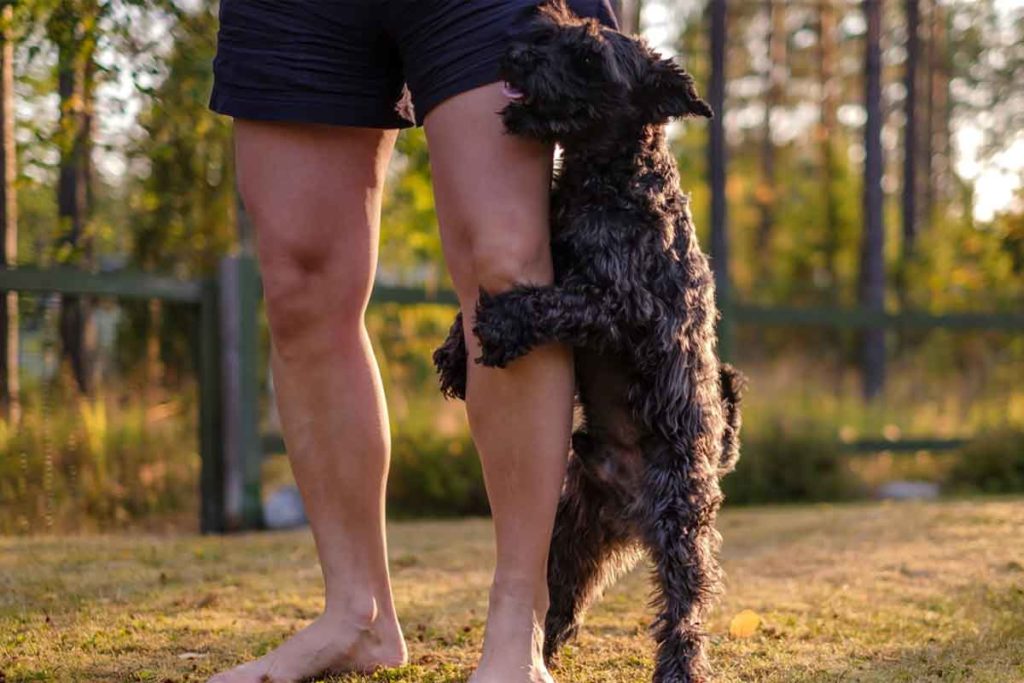Humping is a very common behavior in dogs. Despite appearances, it is not always sexually motivated and is typically harmless. There are, however, some situations in which humping can be problematic and simply awkward.
So, why do dogs hump other dogs, people, and objects? Should you curb your dog’s humping habit?
Table of contents
- What is humping?
- Why do dogs hump?
- How can ElleVet’s CBD + CBDA help stressed dogs?
- When does humping become problematic?
- What if my dog is neutered?
- How to get your dog to stop humping
- Bottom line on humping
What is humping?
Most dog owners are familiar with seeing their dog or other dogs hump something or someone. The act of humping, also referred to as mounting, involves a dog putting their front legs around another dog, typically from the rear, and thrusting their pelvis repeatedly.
Because humping is most often considered in a sexual context, people tend to assume that only male dogs, particularly intact ones, partake in humping. However, neutered males and both intact and spayed female dogs can also exhibit humping behavior.
Why do dogs hump?
Mounting is a natural, instinctive behavior in all dogs. It can happen for several reasons:
Dominance
Animal behaviorist Dr. Mary Burch notes that humping is often an attempt at dominance and to display social status or control. This can apply whether it’s a human or another dog on the receiving end. However, the dog doing the humping isn’t always the one trying to dominate the other. A more insecure dog may hump a more confident dog simply because they don’t have the social skills to otherwise deal with the situation. Dogs who are unsure of their place in the pack are more likely to hump to see how many dogs will accept the behavior. And a confident dog may let them!
Play
Brief moments of humping between dogs can be a normal part of play behavior. For instance, while running and playing, dogs might take turns mounting each other in a harmless expression of excitement. Like play fighting or wrestling, it’s not unusual to see a dog try to initiate play with another by humping. This can be a normal and acceptable behavior between two dogs as long as it doesn’t upset either of them. Some poorly socialized dogs excessively mount other dogs in response to play solicitation. They don’t seem to know how to play well and get overaroused during play.
Sexual/hormonal
Although rarer than we tend to assume, your dog may still hump other dogs due to hormones and sexual attraction. The likelihood of humping being sexual in nature is greater in younger dogs that have not been spayed or neutered. This is why pet parents may notice puppies approaching sexual maturity (around 5–8 months old) start humping. Dogs can smell when a female dog is about to go into heat, and this can trigger the instinctual response to mount, even in neutered males. When both dogs are intact, humping can quickly turn into mating, so intact dogs of the opposite sex should be kept separate if you don’t want that to happen. Having your dog neutered or spayed may help with the problem, but be aware that dogs may develop the habit of humping before they’re altered and continue it afterward.
Medical
Occasionally, humping can be a sign of a medical problem. For instance, humping can signal infection or irritation, or, in male dogs, prostate problems. Although not common, some possible medical issues that could lead to humping include:
- Urinary tract infections — These are generally painful and may cause discomfort and swelling of the genitals. Humping may help relieve this discomfort.
- Skin issues and infections — Many skin issues are often itchy and cause irritation. Humping may be an alternative to chewing or licking to relieve discomfort, pain, and frustration.
- Priapism — Priapism refers to persistent erections. When erections last for an extended period of time, it can be painful, and instead of licking, some dogs hump to ease the pain.
If your dog is suffering a medical issue, humping can be similar to other behaviors such as licking the genital area or rubbing against furniture or other objects. These issues can be serious if not properly treated and require medical attention rather than behavioral treatment. Before you try to train your dog not to hump, you should rule out any medical causes. If you notice your dog excessively mounting, licking or chewing himself, or rubbing his body against things, take him to a veterinarian to rule out medical concerns.
Overstimulation
Humping can be a sign that a dog is stressed, overstimulated, or uncomfortable. When a pillow or stuffed animal are the objects of your dog’s affection, there’s a good chance the dog has simply gotten excited and overstimulated. A dog can start humping when they get really excited, such as when you arrive home after they’ve been alone all day or when guests come over to visit.
Mounting is sometimes a self-soothing behavior for dogs who are stressed, according to veterinary expert Dr. Cathy Madson. This could happen when they are at a dog park or doggy daycare, and there are a lot of different dogs and play styles that your dog can’t control.
How can ElleVet’s CBD + CBDA help stressed dogs?
ElleVet’s CBD + CBDA chews, soft gels, and oils can offer support for dogs’ stress by helping their stress levels decrease and return to a normal state of balance. CBD + CBDA truly calms without sedating, which is key to allowing dogs to handle stressful situations like meeting strangers or overstimulation at the dog park.
When does humping become problematic?
While humping is generally a harmless habit, there are some reasons to consider discouraging the behavior in your dog. For one, the sexual connotation of humping can make for an embarrassing and uncomfortable situation for pet owners and those around you. And you probably don’t want your dog to constantly steal couch pillows for humping purposes. Of not addressed, frequent humping, especially in young dogs, can become a lifelong habit.
Additionally, the dog or person your dog has chosen to hump may not appreciate the gesture. Other dog owners may not want your dog mounting theirs. For some dogs, this may lead to dangerous, aggressive reactions. So, in the interest of avoiding any potential conflict, it’s best to keep humping to a minimum.
Large dogs can inadvertently injure smaller or older dogs by mounting them. And the same can be said for young children, seniors, and others who may not be able to physically handle a dog on top of them. In addition to potentially injuring others, intense humpers are at risk of hurting themselves. Long-backed dogs like Dachshunds and Corgis can suffer ruptured spinal discs from enthusiastic movements involved in humping.
If your dog’s humping behavior is caused by stress, letting the issue go unaddressed can allow your dog’s stress to worsen over time. Humping may escalate to more reactive behaviors. And we know that severe, long-term stress can negatively impact your dog’s physical and mental health, causing their overall well-being to suffer.
What if my dog is neutered?
Having your male dog neutered can certainly help reduce hormone-related humping. However, it’s important to address your dog’s humping behavior prior to neutering if it is driven by hormones. Not because it’s bad—after all, it’s a natural and instinctual behavior. But hormone-driven behaviors can become lifetime habits even after neutering. If a dog rehearses humping behavior over and over, it becomes self-reinforcing and will not just disappear after being neutered.
How to get your dog to stop humping
You don’t want your dog humping your guests or getting into an altercation with an unwelcoming dog at the park. Even humping an object can potentially cause damage to your belongings.
The best way to treat humping is to redirect your dog’s attention and energy to a more desirable activity. This lets the dog know that the behavior is not wanted, and allows for positive reinforcement if they successfully perform another command.
When the humping starts, immediately interrupt your dog and ask them to sit, lie down, or stay. Alternatively, redirect with a game of fetch or by taking the dog outside for some exercise. Reward them for following your command or engaging in another activity. If you are not able to successfully use positive reinforcement to curb your dog’s humping, you may want to consider seeking professional help from an animal behaviorist.
Bottom line on humping
Humping is a natural dog behavior and can be a sign your dog needs support if they are overwhelmed or stressed. It is crucial for pet parents to address their dog’s stress, and there are several other important reasons you should consider getting your dog to stop humping other dogs, people, and objects. It is important to remember, however, that humping is a natural behavior and should be addressed using positive reinforcement methods.









